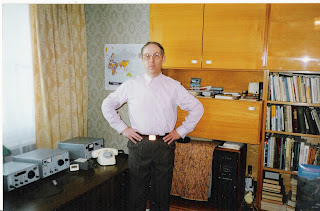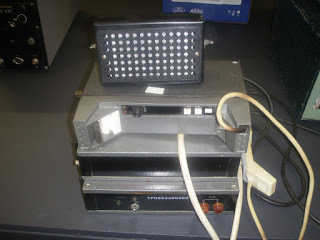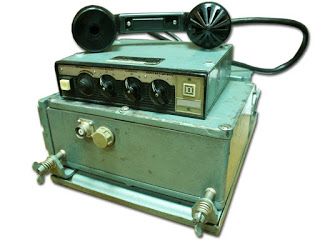3. Hardware
used in Toompea castle (Tallinn, Estonia):
Portable tranceiver "Angara - 1"

Frequency range: 1,6 - 7,999 MHz, CW and USB mode, 10w
R - 250M
R-250, R-250M and R-250M2 where the most prominent
and remarkable Russian short wave receivers. The receiver line produced and
modernised from 1948 until 1981.
The receiver was mainly used in soviet and her allied armed forces. Later often
found in HAM radio clubstations. 1.5-25.5 MHz in 12 ranges (turret tuner), with
optional extension kit four additional ranges up to 33.5 MHz, AM/SSB/CW,
optical projection tuning scale.
Tranceiver "Efir - M"
Transceiver Efir was produced since the end of 70s of the 20
Century. Bands: 1,8; 3,5; 7; 14; 21 and 28 mc. CW and SSB mode.
HF homebrew amplifier
About 500 Watt output
R-311
R311 – “Portable” tube military
HF receiver intended for range 1.0 – 15.0 MHz, receives AM, CW and SSB. R- 311s
were produced from the beginning of 50 till end of 1970.
R- 311 were used at a radio-
intelligence division. Then it was widely used in USSR Army- in tank, in ship,
like army headquarter monitoring receiver for receiving routine radiogram,
weather forecast, like military training receiver, etc. The receiver works well
both with short and long antennas. R- 311 practically has no rustle without an
antenna.
Homebrew "80m" tranceiver
Russian Military Aircraft Receiver R-872.
Frequency
range: 100 ...
149.975 MHz
Technical
data: Channels: 100
... 149.975 MHZ: 2000
Channel
spacing: 25 kHz Modes: AM, FM, Frequency telegraphy
R - 123 M
Transceiver
R-123: military frequency modulated shortwave / VHF
transceiver, frequency coverage 20,0 - 51,5 MHz (band 1: 20,0 - 35,75 MHz, band
2: 35,75 - 51,5 MHz, 1261 channels with 25 Khz channel spacing), optical tuning
system with frequency projected to a glass plate, operation mode frequency
modulated telephony F3, output power 20 Watts.
Baklan - 20
The airborne VHF two-way
transceivers are intended for establishing of radio communication (simplex
operation) between the crews of airplanes and helicopters and with air traffic
controllers of the ground air traffic control services.
Control of the transceiver and
setting of the demanded frequency is carried out with the help of the remote
control panel. Frequency range: 116.000 to 136.975. Output power min. 16 W, AM mode.
Modernized "Baklan-20"
| Frequency range: | 136.000 to 157.975 MHz, FM mode, 20 watt |
Modernized housing "Baklan - 20"
| Frequency range | 116.000 to 136.975, Transmitter output power, min 16 W; AM mode. |
FM Radio Receiver
Radiostation "Majak"
Receiver R - 375 "Kaira"
Frequency range: 20 - 500 MHz,
spy services
R-148
is a recent fully transistorized portable radio. It was used on company
level. Frequency
range: 37.00 ...
51.950 MHz Technical data: Channel spacing: 50 KHz Modulation: FM. HF
output: 1 W.
VOLNA-K
The Volna-K is a
Russian Navy HF receiver. It was intended as a maritime receiver for the Navy
and for commercial shipping. It is a superheterodyne double conversion HF
receiver, using 17 miniature valves, and 2 semi-conductor diodes. The valves
have Russian numbers, but are equivalent to common American types. It is
intended to receive AM and CW signals down to 0.5 uV levels. The word
"volna" translates to "wave". The frequency coverage is 12
kHz to 23 mHz in 9 bands, with gaps around the IF frequencies. There are 3
versions of the Volna-K, each with a slightly different frequency coverage.
There is also Volna-P which is the version for submarines.
Radiostation "Palma"
Radiostation "Лён-БМ"
R-158
is a modern Russian Portable. It is solid state. I am trying to find out
where it was used.
Frequency
range: 30.000 ...
79.975 MHz Frequency displayed by: 4
switches
Channel
spacing: 25 KHz. HF output: 1 W Sensitivity: 1 µV Powered by: 12.6 V,
internally or externally. Temperature
range: - 40 ... + 50 °C
"Len - B"
"Len - B"
Homebrew FM tranceiver for 2m band
Portable 2m FM tranceiver
for Prime Minister
"R - 123M"

Primary jammer!















































